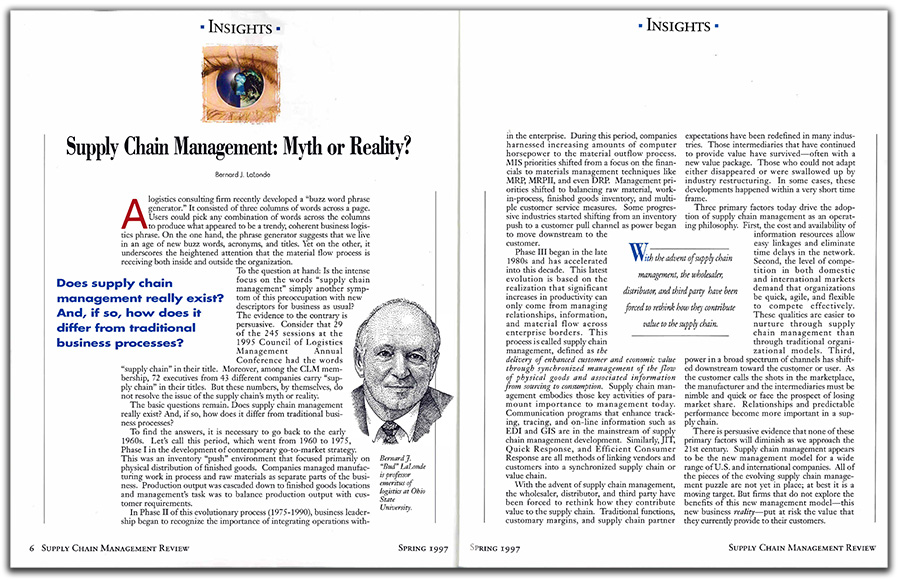A logistics consulting firm recently developed a “buzz word phrase generator.” It consisted of three columns of words across a page. Users could pick any combination of words across the columns to produce what appeared to be a trendy, coherent business logistics phrase. On the one hand, the phrase generator suggests that we live in an age of new buzz words, acronyms, and titles. Yet on the other, it underscores the heightened attention that the material flow process is receiving both inside and outside the organization.
To the question at hand: Is the intense focus on the words “supply chain management” simply another symptom of this preoccupation with new descriptors for business as usual? The evidence to the contrary is persuasive. Consider that 29 of the 245 session at the 1995 Council of Logistics Management Annual Conference had the words “supply chain” in their titles. But these numbers, by themselves, do not resolve the issue of the supply chain’s myth or reality.
The basic questions remain. Does supply chain management really exist? And, if so, how does it differ from traditional business processes?
To find the answers, it is necessary to go back to the early 1960s. Let’s call this period, which went from 1960 to 197 5, Phase I in the development of contemporary go-to-market strategy. This was an inventory “push” environment that focused primarily on physical distribution of finished goods. Companies managed manufacturing work in process and raw materials as separate parts of the business. Production output was cascaded down to finished goods locations and management’s task was to balance production output with customer requirements.

This article originally appeared in the first ever issue of Supply Chain Management Review. Spring 1997
In Phase II of this evolutionary process (1975-1990), business leadership began to recognize the importance of integrating operations within the enterprise. During this period, companies harnessed increasing amounts of computer horsepower to the material outflow process. MIS priorities shifted from a focus on the financials to materials management techniques like MRP, MRPII, and even DRP. Management priorities shifted to balancing raw material, workin- process, finished goods inventory, and multiple customer service measures. Some progressive industries started shifting from an inventory push to a customer pull channel as power began to move downstream to the customer.
Phase III began in the late 1980s and has accelerated into this decade. This latest evolution is based on the realization that significant increases in productivity can only come from managing relationships, information, and material flow across enterprise borders. This process is called supply chain management, defined as the delivery of enhanced customer and economic value through synchronized management of the flow of physical goods and associated in formation from sourcing to consumption. Supply chain management embodies those key activities of paramount importance to management today. Communication programs that enhance tracking, tracing, and on-line information such as EDI and GIS are in the mainstream of supply chain management development. Similarly, JIT, Quick Response, and Efficient Consumer Response are all methods of linking vendors and customers into a synchronized supply chain or value chain.
With the advent of supply chain management, the wholesaler, distributor, and third party have been forced to rethink how they contribute value to the supply chain. Traditional functions, customary margins, and supply chain partner expectations have been redefined in many industries. Those intermediaries that have continued to provide value have survived-often with a new value package. Those who could not adapt either disappeared or were swallowed up by industry restructuring. In some cases, these developments happened within a very short time frame.
Three primary factors today drive the adoption of supply chain management as an operating philosophy. First, the cost and availability of information resources allow easy linkages and eliminate time delays in the network. Second, the level of competition in both domestic and international markets demand that organizations be quick, agile, and flexible to compete effectively. These qualities are easier to nurture through supply chain management than through traditional organizational models. Third power in a broad spectrum of channels has shifted downstream toward the customer or user. As the customer calls the shots in the marketplace, the manufacturer and the intermediaries must be nimble and quick or face the prospect of losing market share. Relationships and predictable performance become more important in a supply chain.
There is persuasive evidence that none of these primary factors will diminish as we approach the 21st century. Supply chain management appears to be the new management model for a wide range of U.S. and international companies. All of the pieces of the evolving supply chain management puzzle are not yet in place; at best it is a moving target. But firms that do not explore the benefits of this new management model-this new business reality-put at risk the value that they currently provide to their customers.
SC
MR


Latest Supply Chain News
- How CPG brands can deliver on supplier diversity promises
- How S&OP provides the answer to in-demand products
- AI, virtual reality is bringing experiential learning into the modern age
- Humanoid robots’ place in an intralogistics smart robot strategy
- Tips for CIOs to overcome technology talent acquisition troubles
- More News
Latest Podcast

 Explore
Explore
Business Management News
- How CPG brands can deliver on supplier diversity promises
- How S&OP provides the answer to in-demand products
- AI, virtual reality is bringing experiential learning into the modern age
- Tips for CIOs to overcome technology talent acquisition troubles
- There is still work to do to achieve supply chain stability
- Blooming success: The vital role of S&OE in nurturing global supply chains
- More Business Management
Latest Business Management Resources

Subscribe

Supply Chain Management Review delivers the best industry content.

Editors’ Picks





